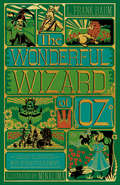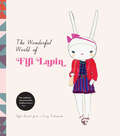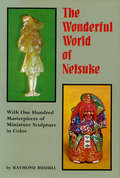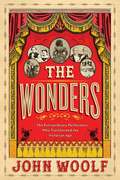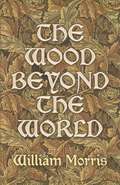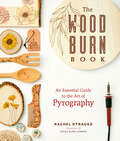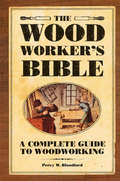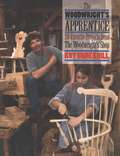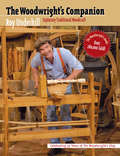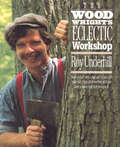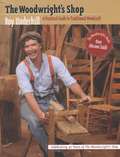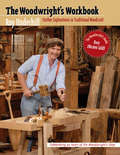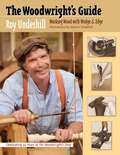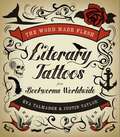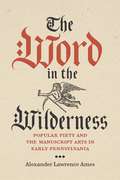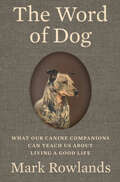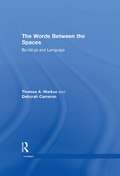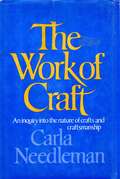- Table View
- List View
The Wonderful Wizard of Oz
by L. Frank BaumA deluxe gift edition of L. Frank Baum’s cherished children’s classic, vividly reimagined with beautiful four-color artwork and nine interactive features created by MinaLima, the award-winning design studio behind the graphics for the Harry Potter film franchise.Hailed as “America’s greatest and best-loved homegrown fairytale” by the Library of Congress, L. Frank Baum’s classic story has been enjoyed by generations of young readers since its publication in 1900. One of the most-read children’s books, it is a staple of American literature and the inspiration for the beloved 1939 Academy Award-winning movie (widely acclaimed as one of the greatest films of all time), as well as stage plays and musicals.When a tornado strikes the Kansas prairie, young orphan Dorothy Gale and her little dog Toto are blown away to Oz, a magical place filled with witches, munchkins, winged monkeys, and other unusual inhabitants. Lost and afraid, all Dorothy wants is to return to her Uncle Henry and Auntie Em. But to do so, the Good Witch of the North tells her, she must follow the Yellow Brick Road that leads to the Emerald City. There, she will find the fearsome Wizard of Oz who can help her find her way home. Along the way, Dorothy encounters three unforgettable characters—the Scarecrow, the Tinman, and the Cowardly Lion—who join her in her quest. Their journey to the Emerald City, fraught with peril and adventure, teaches them the true meaning of friendship and reminds us all that there is no place like home. The Wonderful Wizard of Oz Interactive reimagines the novel’s iconic imagery and highlights phrases from the original book in a unique and delightful style that will enchant readers of all ages. Sure to become a collector’s item, this deluxe illustrated edition contains specially commissioned artwork and nine exclusive interactive features, including:A cyclone map that opens up to reveal the Land of OzA pop-up Yellow Brick RoadOz glasses that provide a different look at the worldFighting trees with branches that moveDorothy’s silver shoes that can be clicked togetherThis marvelous edition will enchant young and adult readers and is a thoughtful gift for any occasion.
The Wonderful World of Fifi Lapin: Style Secrets of a Furry Fashionista
by Fifi LapinEven the most savvy fashionistas have a lot to learn from the "world's most stylish bunny" (Elle). Indeed, Fifi Lapin—a spoiled rotten illustrated rabbit and in-demand fashion blogger—knows her couture from her carrots. Her blog of whimsical outfit choices and fashion musings has made her an icon among designers, style bloggers, and thousands of fans worldwide. Here, she reveals the best of her fashion secrets, sharing advice on finding the perfect pair of jeans, layering trends with classics, and crafting personal style without paying couture prices (like she does). With a perfectly pretty cover, hundreds of cute illustrations and runway photos, plus inspiring interviews with top designers such as Anna Sui and Paul Smith, this is every fun-loving girl's go-to guide to looking fabulous every day of the week.
The Wonderful World of Netsuke
by Raymond BushellRoughly a century ago, when Japan emerged from the long seclusion of the Edo period and opened her doors to the West, a treasury of fascinating objets d'art was exposed to view. By no means the least fascinating among the discoveries by Westerners were the miniature works of art known as netsuke. These tinymasterpieces of sculpture (mostly in ivory and wood), of lacquer, and of metalwork captivated collectors with the charm of their conception, the intricacy of their detail, and the sheer tactile pleasure of handling them. Basically they were utilitarian in purpose, serving as toggles or pendants to support medicine boxes, to bacco pouches, and similar articles suspendedby a cord from the obi. Originally primitive in design, they soon became moreand more sophisticated, and their makers turned increasingly to the legendry of Japan for their subject matter. It is with these masterpieces in miniaturethat author-collector Raymond Bushell deals in The Wonderful World of Netsuke} picturing one hundred of them in color and offering a delightfully informative description of each. In so doing, he provides not only a visual treat but also an absorbing commentary on Japanese manners, customs, history, legends, andsuperstitions. Mr. Bushell, besides being an avid collector of netsuke, sword furnishings, and jade, is widely known for his adaptation from the Japanese of The Netsuke Handbook of Ueda Reikichi.
The Wonderful World of Netsuke
by Raymond BushellRoughly a century ago, when Japan emerged from the long seclusion of the Edo period and opened her doors to the West, a treasury of fascinating objets d'art was exposed to view. By no means the least fascinating among the discoveries by Westerners were the miniature works of art known as netsuke. These tinymasterpieces of sculpture (mostly in ivory and wood), of lacquer, and of metalwork captivated collectors with the charm of their conception, the intricacy of their detail, and the sheer tactile pleasure of handling them. Basically they were utilitarian in purpose, serving as toggles or pendants to support medicine boxes, to bacco pouches, and similar articles suspendedby a cord from the obi. Originally primitive in design, they soon became moreand more sophisticated, and their makers turned increasingly to the legendry of Japan for their subject matter. It is with these masterpieces in miniaturethat author-collector Raymond Bushell deals in The Wonderful World of Netsuke} picturing one hundred of them in color and offering a delightfully informative description of each. In so doing, he provides not only a visual treat but also an absorbing commentary on Japanese manners, customs, history, legends, andsuperstitions. Mr. Bushell, besides being an avid collector of netsuke, sword furnishings, and jade, is widely known for his adaptation from the Japanese of The Netsuke Handbook of Ueda Reikichi.
The Wonders of Creation: Learning Stewardship from Narnia and Middle-Earth (Hansen Lectureship Series)
by Kristen PageWhen an author of fiction employs the imagination and sets characters in a new location, they are in a sense creating a world. Might such fictional worlds give us a deeper appreciation for our own?Many readers have found themselves, like the Pevensie children, transported by C. S. Lewis into Narnia, and they have traveled from Lantern Waste to Cair Paravel and the edge of the sea. Thanks to J. R. R. Tolkien, readers have also journeyed with Bilbo, Frodo, and their companions across Middle-earth from the Shire to the Lonely Mountain, the forest of Mirkwood, the mines of Moria, and the very fires of Mount Doom. But as often as we enter these fictional worlds as readers, we eventually return to our world refreshed with sharpened insight.The Wonders of CreationBased on the annual lecture series hosted at Wheaton College's Marion E. Wade Center, volumes in the Hansen Lectureship Series reflect on the imaginative work and lasting influence of seven British authors: Owen Barfield, G. K. Chesterton, C. S. Lewis, George MacDonald, Dorothy L. Sayers, J. R. R. Tolkien, and Charles Williams.
The Wonders: The Extraordinary Circus Performers Who Transformed The Victorian Age
by John WoolfA radical new history that rediscovers the remarkable freak performers whose talents and charisma helped define an era. On March 23, 1844, General Tom Thumb, just 25 inches tall, entered the Picture Gallery at Buckingham Palace and bowed low to Queen Victoria. On both sides of the Atlantic, this meeting marked a tipping point in the nineteenth century, and the age of the freak was born. Bewitching all levels of society, it was a world of curiosities and astonishing spectacle—of dwarfs, giants, bearded ladies, Siamese twins, and swaggering showmen. But the real stories—human dramas that so often eclipsed the fantasy presented on the stage—of the performing men, women and children, have been forgotten or marginalized in the histories of the very people who exploited them. In this richly evocative account, John Woolf uses a wealth of recently discovered material to bring to life the sometimes tragic, sometimes triumphant, always extraordinary stories of people who used their (dis)abilities and difference to become some of the first international celebrities. Through their lives we discover afresh some of the great transformations of the age: the birth of show business, of celebrity, of advertising, and of “alternative facts” while also exploring the tensions between the power of fame, the impact of exploitation, and our fascination with “otherness.”
The Wood Beyond the World
by William MorrisThe name Kelmscott bears a legendary and magical sound among bibliophiles. When William Morris founded the Kelmscott Press in 1890, he combined his medieval craft ideals with his skills as one of Britain's most sophisticated, progressive designers. He achieved his goal — the creation of books as beautiful as those of the Middle Ages — by abandoning many of the commercial practices of his day. Morris designed types of great elegance and reintroduced color into the body of the page, adding life to the printed word.Even if there were enough copies for everyone who wanted one, the cost of original Kelmscott books is prohibitively expensive. For this reason, Dover Publications has reissued one of Morris's most noteworthy books in a photographic facsimile that retains the enchantment of the original edition. More than an exquisitely produced book, The Wood Beyond the World ranks among the finest of Morris's prose-romances, a wonderful fantasy in a medieval setting, brimming with high adventure and flights of fancy. This superbly illustrated novel was among the first to combine reality and the supernatural, and it served as inspiration for J. R. R. Tolkien, C. S. Lewis, and countless other fantasists.
The Wood Burn Book: An Essential Guide to the Art of Pyrography
by Rachel StraussLearn the art of wood burning from a master of the craft in this comprehensive guide to the tools and techniques of “writing with fire.”The Wood Burn Book opens with a brief background to the art of wood burning, an overview of tools and materials, basic techniques, and safety tips. You will also find a detailed explanation of the process from start to finish, with patterns, advanced techniques for lettering and adding color, as well as dozens of projects, including picture frames, cutting boards, coasters, cards, wooden spoons, and jewelry.
The Woodworker's Bible: A Complete Guide to Woodworking
by Percy BlandfordWoodworking is TimelessThings change, to be sure, and woodworking is no exception. New tools come on the market, older tools are upgraded and a number of new, finely made hand tools are now available. Regardless of the subtle changes, the basic principles used by woodworkers have remained constant.The novice woodworker can produce satisfactory work following these unchanging woodworking traditions and using just some basic tools. Once these lessons are learned, all woodworking tasks are only a short step away. Power tools can take much of the drudgery out of woodworking, hand tools bring you closer to your work to teach you the characteristics of wood and how to make the most of the material.This book offers all the knowledge needed to get started in woodworking. All of the joints, jigs, methods, techniques and processes that have stood the test of time are included (along with a number of basic projects to practice the techniques). Woodworking offers enough variety to satisfy the widest range of tastes and inclinations. Let this book be your guide for whatever direction you want your work to take.
The Woodworker's Kitchen: 24 Projects You Can Make
by A. J. HamlerShow off your woodworking skills--in the kitchen! Anyone who has ever entertained knows that guests inevitably end up in the kitchen--so what better place to showcase your woodworking? Why not add a hand-crafted focal point--a kitchen island or handsome touches such as a cutting board, spice rack, or rolling pin? Whether you are outfitting your own kitchen or looking for a gift idea for a fellow foodie, The Woodworker's Kitchen has a range of woodworking projects sure to add that special touch. The 24 projects inside include:A customized knife block that does double-duty as a tablet holder, allowing you to pull up recipes and watch cooking videos with easeA kitchen island with a built-in wine rackAn oven peel perfect for gourmet pizzas and toasted sandwichesA K-Cup organizer to help tame those caffeine cravingsA rolling grill cart for your outdoor cooking adventuresA fancy bread knife/cutting board comboAnd many more!Detailed instructions, measured drawings, patterns and step-by-step color photos make constructing these projects easy. See what you can cook up in the shop and add some woodworking charm to your kitchen!
The Woodwright's Apprentice
by Roy UnderhillFor more than twenty years, Roy Underhill has taught the techniques of traditional woodcraft with muscle-powered tools. With his four previous books and his popular PBS series, The Woodwright's Shop, now in its sixteenth season, Roy has inspired millions to take up chisel and plane. The master woodwright returns here with instructions for handcrafting an appealing selection of projects from the American woodworking tradition. The Woodwright's Apprentice begins with directions for building a workbench. Each successive project builds new skills for the apprentice woodworker--from frame construction to dovetailing, turning, steam-bending, and carving. Among the twenty items featured are an African chair, a telescoping music stand, a walking-stick chair, a fireplace bellows, and a revolving Windsor chair. Designed both for woodworking novices and for more seasoned woodworkers looking for enjoyable projects, the book includes step-by-step directions, complete with easy-to-follow photographs and measured drawings, and an illustrated glossary of tools and terms. All of the pieces presented here are based on projects featured in past and upcoming seasons of The Woodwright's Shop television show.
The Woodwright's Companion
by Roy UnderhillWith The Woodwright's Companinon, Roy Underhill continues to demonstrate "how to start with a tree and an axe and make one thing after another until you have a house and everything in it." This volume features chapters on helves and handles, saws, the search for the whetstone quarry, crow chasers and turkey calls, hurdles, whimmy diddles, snaplines and marking gauges, candle stands, planes, window sash, riven shingles, and pit sawing. The final chapter offers a glimpse of traditional woodworking techniques still used by the Colonial Williamsburg housewrights. More than 260 photographs complement the text.
The Woodwright's Eclectic Workshop
by Roy UnderhillFor more than ten years, Roy Underhill has taught the techniques of traditional woodcraft, or 'how to start with a tree and an axe and make one thing after another until you have a house and everything in it.' Through his popular PBS series, The Woodwright's Shop,' and his previous books, Roy has inspired millions--from professional craftspeople to armchair woodworkers--with his talent, knowledge, and enthusiasm. Roy returns now with his fourth book, The Woodwright's Eclectic Workshop. It features step-by-step instructions for many projects featured on the television series in recent years, including such popular projects as the Adirondack chair, tavern table, folding ladder, rocking horse, lathe, and kayak. All projects are illustrated with photographs and measured drawings. The book also includes colorful descriptions of what it was like to be a tradesperson who made a living by hand, working with the tools and methods Roy describes on television and in his books: carpenters, joiners, wheelwright, millwrights, chairmakers, and blacksmiths. As Roy puts it, he wants to examine 'the old paths in the way that they were originally taken: not as adventuresome recreations but a profession that put food on the table and clothes on the kids.'
The Woodwright's Shop
by Roy UnderhillRoy Underhill brings to woodworking the intimate relationship with wood that craftsmen enjoyed in the days before power tools. Combining historical background, folklore, alternative technololgy, and humor, he provides both a source of general information and a detailed introduction to traditional woodworking. Beginning with a guide to trees and tools, The Woodwright's Shop includes chapters on gluts and mauls, shaving horses, rakes, chairs, weaving wood, hay forks, dough bowls, lathes, blacksmithing, dovetails, panel-frame construction, log houses, and timber-frame construction. More than 330 photographs illustrate the text.For more than twenty-five years, Roy Underhill has taught the techniques of traditional hand-tool woodworking. In five books and on his popular, long-running PBS series, The Woodwright's Shop, America's leading authority on old-time woodcraft has inspired millions to take up chisel and plane. Designed for both woodworking novices and for more seasoned woodworkers looking for enjoyable projects, the books feature step-by-step instructions, complete with easy-to-follow photographs and measured drawings. Roy Underhill is the former master housewright at Colonial Williamsburg. He created The Woodwright's Shop, one of the first television programs devoted to woodworking, in 1979. The series is produced by the University of North Carolina Center for Public Television and has aired nationally since 1981. Roy is a graduate of the University of North Carolina at Chapel Hill and holds a master's degree from Duke University. He lives in Williamsburg, Virginia.The Woodwright's ShopA Practical Guide to Traditional WoodcraftFeatures a guide to trees and tools as well as chapters on gluts and mauls, shaving horses, chairs, lathes, blacksmithing, log houses, and more.The Woodwright's CompanionExploring Traditional WoodcraftIncludes chapters on helves and handles, saws, the search for the whetstone quarry, hurdles, whimmy diddles, planes, window sashes, and pit sawing.The Woodwright's WorkbookFurther Explorations in Traditional WoodcraftWith step-by-step instructions for tool chests, workbenches, lathes, and historical reproductions of items for the home. Roy also explores building barns, boats, and even colonial fortresses.The Woodwright's Eclectic WorkshopPopular projects include the Adirondack chair, tavern table, folding ladder, rocking horse, lathe, and kayak, all illustrated with photographs and measured drawings. The Woodwright's ApprenticeTwenty Favorite Projects from The Woodwright's ShopBegins with directions for building a workbench, then builds new skills--from frame construction to dovetailing, turning, steam-bending, and carving--with each successive project.-->
The Woodwright's Workbook
by Roy UnderhillRoy Underhill is America's best-known master of traditional woodcraft. Creator of the popular PBS series The Woodwright's Shop, Roy has inspired millions--from professional craftsman to armchair woodworker--with his talent, knowledge, and enthusiasm. Roy returns here with his third book. The Woodwright's Workbook features step-by-step instructions for a selection of projects from his television series. All projects are illustrated with photographs and measured drawings. Included here are plans for tool chests, workbenches, lathes, and historical reproductions of items for the home: a six-board chest, rustic chairs with cattail seats, a churn for the kitchen, and the Rittenhouse hygrometer. Roy also explores building barns, forges, boats, and even colonial fortresses. A wonderful feature of this book is Roy's own translation of the humorous fifteenth-century poem The Debate of the Carpenter's Tools. He also provides a fascinating and useful 'field guide' to American tool marks that shows how to identify the specific tool used by the marks it left. Whether Roy is an old friend or a new acquaintance, let him be your guide to the world of traditional woodworking.
The Woodwright’s Guide
by Roy UnderhillFor thirty years, Roy Underhill's PBS program, The Woodwright's Shop, has brought classic hand-tool craftsmanship to viewers across America. Now, in his seventh book, Roy shows how to engage the mysteries of the splitting wedge and the cutting edge to shape wood from forest to furniture.Beginning with the standing tree, each chapter of The Woodwright's Guide explores one of nine trades of woodcraft: faller, countryman and cleaver, hewer, log-builder, sawyer, carpenter, joiner, turner, and cabinetmaker. Each trade brings new tools and techniques; each trade uses a different character of material; but all are united by the grain in the wood and the enduring mastery of muscle and steel.Hundreds of detailed drawings by Eleanor Underhill (Roy's daughter) illustrate the hand tools and processes for shaping and joining wood. A special concluding section contains detailed plans for making your own foot-powered lathes, workbenches, shaving horses, and taps and dies for wooden screws.The Woodwright's Guide is informed by a lifetime of experience and study. A former master craftsman at Colonial Williamsburg, Roy has inspired millions to "just say no to power tools" through his continuing work as a historian, craftsman, activist, and teacher. In The Woodwright's Guide, he takes readers on a personal journey through a legacy of off-the-grid, self-reliant craftsmanship. It's a toolbox filled with insight and technique as well as wisdom and confidence for the artisan in all of us.
The Word Made Flesh
by Justin Taylor Eva TalmadgeThe Word Made Flesh: Literary Tattoos from Bookworms Worldwide is a guide to the emerging subculture of literary tattoos-a collection of more than 150 full-color photographs of human epidermis indelibly adorned with quotations and illustrations from Dickinson to Pynchon, from Shakespeare to Plath. With beloved lines of verse, literary portraits, and illustrations-and statements from the bearers on their tattoos' history and the personal significance of the chosen literary work-The Word Made Flesh is part collection of photographs and part literary anthology written on skin.
The Word in Stone: The Role of Architecture in the National Socialist Ideology
by Robert R. TaylorThis title is part of UC Press's Voices Revived program, which commemorates University of California Press’s mission to seek out and cultivate the brightest minds and give them voice, reach, and impact. Drawing on a backlist dating to 1893, Voices Revived makes high-quality, peer-reviewed scholarship accessible once again using print-on-demand technology. This title was originally published in 1974.
The Word in the Wilderness: Popular Piety and the Manuscript Arts in Early Pennsylvania (Pietist, Moravian, and Anabaptist Studies #5)
by Alexander Lawrence AmesOnce a vibrant part of religious life for many Pennsylvania Germans in the eighteenth and nineteenth centuries, Fraktur manuscripts today are primarily studied for their decorative qualities. The Word in the Wilderness takes a different view, probing these documents for what they tell us about the lived religious experiences of the Protestant communities that made and used them and opening avenues for reinterpretation of this well-known, if little understood, set of cultural artifacts.The resplendent illuminated religious manuscripts commonly known as Fraktur have captivated collectors and scholars for generations. Yet fundamental questions about their cultural origins, purpose, and historical significance remain. Alexander Lawrence Ames addresses these by placing Fraktur manuscripts within a "Pietist paradigm," grounded in an understanding of how their makers viewed "the Word," or scripture. His analysis combines a sweeping overview of Protestant Christian religious movements in Europe and early America with close analysis of key Pennsylvania devotional manuscripts, revealing novel insights into the religious utility of calligraphy, manuscript illumination, and devotional reading as Protestant spiritual enterprises. Situating the manuscripts in the context of transatlantic religious history, early American spirituality, material culture studies, and the history of book and manuscript production, Ames challenges long-held approaches to Pennsylvania German studies and urges scholars to engage with these texts and with their makers and users on their own terms. Featuring dozens of illustrations, this lively, engaging book will appeal to Fraktur scholars and enthusiasts, historians of early America, and anyone interested in the material culture and spiritual practices of the German-speaking residents of Pennsylvania.
The Word in the Wilderness: Popular Piety and the Manuscript Arts in Early Pennsylvania (Pietist, Moravian, and Anabaptist Studies #5)
by Alexander Lawrence AmesOnce a vibrant part of religious life for many Pennsylvania Germans in the eighteenth and nineteenth centuries, Fraktur manuscripts today are primarily studied for their decorative qualities. The Word in the Wilderness takes a different view, probing these documents for what they tell us about the lived religious experiences of the Protestant communities that made and used them and opening avenues for reinterpretation of this well-known, if little understood, set of cultural artifacts.The resplendent illuminated religious manuscripts commonly known as Fraktur have captivated collectors and scholars for generations. Yet fundamental questions about their cultural origins, purpose, and historical significance remain. Alexander Lawrence Ames addresses these by placing Fraktur manuscripts within a “Pietist paradigm,” grounded in an understanding of how their makers viewed “the Word,” or scripture. His analysis combines a sweeping overview of Protestant Christian religious movements in Europe and early America with close analysis of key Pennsylvania devotional manuscripts, revealing novel insights into the religious utility of calligraphy, manuscript illumination, and devotional reading as Protestant spiritual enterprises. Situating the manuscripts in the context of transatlantic religious history, early American spirituality, material culture studies, and the history of book and manuscript production, Ames challenges long-held approaches to Pennsylvania German studies and urges scholars to engage with these texts and with their makers and users on their own terms. Featuring dozens of illustrations, this lively, engaging book will appeal to Fraktur scholars and enthusiasts, historians of early America, and anyone interested in the material culture and spiritual practices of the German-speaking residents of Pennsylvania.
The Word in the World: Essays and Lectures on Indian Literature and Aesthetics
by H S ShivaprakashThe Word in the World is a collection of essays and lectures by H S Shivaprakash, a well-known poet, playwright, and translator. Edited by Kamalakar Bhat, this book brings together Prof Shivaprakash’s interventions in the realm of issues that are entwined with the continuities and discontinuities in the cultural negotiations of India. Distinctively, these are essays on subjects ranging from the nature and significance of medieval works of literature in India to issues arising out of developments in Indian aesthetics. The unfeigned magnitude of this work must be found among students and scholars, who will gain from it a perspective significantly different from the ones available in the prevailing academic discourses, thus indicating a way beyond poststructuralist/postmodernist frameworks. This is a book that will interest a wide variety of readers with its engaging insights and breadth of reference especially because it is written in a comprehensible style. Print edition not for sale in South Asia (India, Sri Lanka, Nepal, Bangladesh, Pakistan and Bhutan)
The Word of Dog: What Our Canine Companions Can Teach Us About Living a Good Life
by Mark RowlandsA heartwarming philosophical meditation on how to live a fulfilling life—inspired by the inherent happiness of dogs. If you have spent any part of your life with a dog, you may have found certain questions popping, unbidden, into your mind: Is my dog living a fulfilled life? Is my dog a good dog? Does my dog love me? Addressing these questions compels you to confront not just your dog’s life but yours as well—to think about what fulfillment, and meaning, in life really is. In The Word of Dog, philosopher Mark Rowlands explores these questions and suggests that in dogs we can see hints—faint, shrouded, but discernible—of what a better way of living might look like. Perhaps none of us can be happy in the way a dog can, but The Word of Dog shows us we could do a lot better than we’re doing simply by listening to the unspoken wisdom our dogs reveal to us every day of their happy, uncomplicated lives.
The Wordless Travel Book: Point at These Pictures to Communicate with Anyone
by Jonathan MeaderIt is a unique triumph for us to present a travel book that helps you communicate without words! All you need to do is point at the icons contained in this inventive little book, and you'll be able to speak a foreign language and be understood. Encased in a sturdy clear plastic jacket for easy travel.From the Trade Paperback edition.
The Words Between the Spaces: Buildings and Language (Architext)
by Deborah Cameron Thomas A. MarkusUsing language - speaking and understanding it - is a defining ability of human beings, woven into all human activity. It is therefore inevitable that it should be deeply implicated in the design, production and use of buildings. Building legislation, design guides, competition and other briefs, architectural criticism, teaching and scholarly material, and the media all produce their characteristic texts.The authors use texts about such projects as Berlin's new Reichstag, Scotland's new Parliament, and the Auschwitz concentration camp museum to clarify the interaction between texts, design, critical debate and response.
The Work Of Craft
by Carla NeedlemanThe Work of Craft is a profound meditation on the relationship between craft and craftsman. Focusing in turn on pottery, weaving, and woodcarving, and grounding her insights in her own experiences as a potter, Carla Needleman shows that the basic material every craftsman works with is himself or herself. The stuff between one's hands-the clay, the wood, the wool-responds to the quality of one's inner state. The product of one's work is not just an object but a way of being. Thus, the exploration of a craft is--like this book--an exploration of the processes of life itself.
